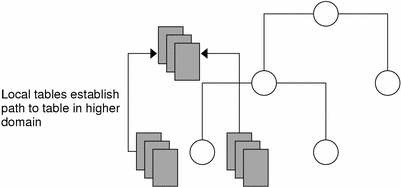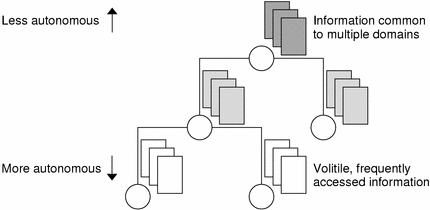Connections Between Tables
NIS+ tables contain information only about the resources and services in their home domain. If a client tries to find information that is stored in another domain, the client has to provide the other domain name. You can make this “forwarding” automatic by connecting the local table to the remote table. NIS+ tables can be connected in two different ways:
-
Through paths.
-
Through links.
Do not use paths and links if you are going to have NIS clients in the NIS+ namespace, because NIS clients are unable to follow the paths or links to find the appropriate information.
Paths
If information in a particular NIS+ table is often requested by clients in other domains, consider establishing a path from the local NIS+ table to the one in the other domain. Refer to the following figure:
Figure 26–8 Establishing a Path to Tables in a Higher Domain

Such a path has two main benefits. First, it saves clients in lower domains the trouble of explicitly searching through a second table. Second, it allows the administrator in the higher-level domain to make changes in one table and render that change visible to clients in other domains. However, such a path can also hurt performance. Performance is especially affected when searches are unsuccessful, because the NIS+ service must search through two tables instead of one. When you use paths, a table lookup now also depends upon the availability of other domains. This dependence can reduce the net availability of your domain. For these reasons, use paths only if you do not have any other solution to your problem.
You should also be aware that since “mailhost” is often used as an alias, when trying to find information about a specific mail host, you should use its fully qualified name in the search path (for example, mailhost.sales.com.); otherwise NIS+ will return all the “mailhosts” it finds in all the domains it searches through.
The path is established in the local table, with the -p option to the nistbladm command. To change a table's path, you must have modify access to the table object. To find a table's search path, use the niscat -o command (you must have read access to the table).
Links
Links between tables produce an effect similar to paths, except that the link involves a search through only one table: the remote table. With a search path, NIS+ first searches the local table, and only if it is unsuccessful does it search the remote table. With a link, the search moves directly to the remote table. In fact, the remote table virtually replaces the local table. The benefit of a link is that it allows a lower domain to access the information in a higher domain without the need to administer its own table.
To create a link, use the nisln command. You must have modify rights to the table object.
Deciding whether to use a path or to link NIS+ tables in a domain is a complex decision, but here are some basic principles:
-
Every domain must have access to every standard table.
-
Volatile, frequently accessed data should be located lower in the hierarchy. Such data should be located closer to where it is used most often.
-
Data that is accessed by several domains should be located higher in the hierarchy, unless the domains need to be independent.
-
Only NIS+ clients can see tables connected by paths and links. They cannot be seen by NIS clients, as illustrated by the following figure:
Figure 26–9 Information Distribution Across an NIS+ Hierarchy

- © 2010, Oracle Corporation and/or its affiliates
